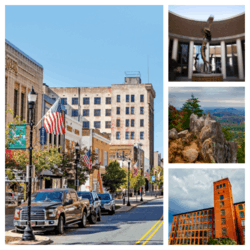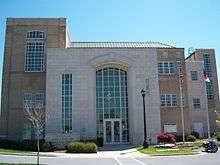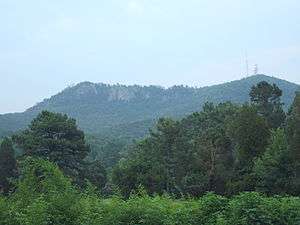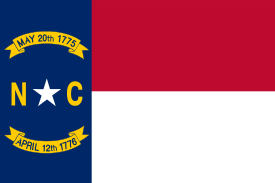Gastonia, North Carolina
Gastonia is the largest city in and county seat of Gaston County, North Carolina, United States. It is the second-largest satellite city of the Charlotte area, behind Concord. The population was 71,741 at the 2010 Census.[5] In 2019, the population had increased to 77,273.[2] Gastonia is the 13th most populous city in North Carolina. It is part of the Charlotte metropolitan area, officially designated the Charlotte Metropolitan Statistical Area (MSA).
Gastonia, North Carolina | |
|---|---|
| City of Gastonia | |
 Clockwise: The Schiele Museum of Natural History, Crowders Mountain State Park, Loray Mill, Downtown Gastonia from Main Avenue | |
| Motto(s): Great Place. Great People. Great Promise. | |
Location in the U.S. state of North Carolina | |
| Coordinates: 35°15′19″N 81°10′49″W | |
| Country | United States |
| State | North Carolina |
| County | Gaston |
| Incorporated | 1877 |
| Government | |
| • Type | Council–manager[1] |
| • Mayor | Walker E. Reid, III (D) |
| Area | |
| • Total | 50.7 sq mi (131.4 km2) |
| • Land | 50.5 sq mi (130.8 km2) |
| • Water | 0.2 sq mi (0.6 km2) |
| Elevation | 797 ft (243 m) |
| Population (2010) | |
| • Total | 71,741 |
| • Estimate (2019)[2] | 77,273 |
| • Density | 1,400/sq mi (550/km2) |
| Time zone | UTC−5 (EST) |
| • Summer (DST) | UTC−4 (EDT) |
| ZIP codes | 28052-28056 |
| Area code(s) | 704, 980 |
| FIPS code | 37-25580[3] |
| GNIS feature ID | 0985606[4] |
| Website | www |
| Wikivoyage has a travel guide for Gastonia. |
The city is a historic center for textile manufacturing and was the site of the Loray Mill Strike of 1929, which became a key event in the labor movement. While manufacturing remains important to the local economy, the city also has well-developed healthcare, education, and government sectors.
History
Gastonia is named for William Gaston, member of the North Carolina Supreme Court.[6]

The City Hospital-Gaston Memorial Hospital, Craig Farmstead, Downtown Gastonia Historic District, First National Bank Building, Gaston County Courthouse, Gastonia High School, David Jenkins House, Loray Mill Historic District, Robinson-Gardner Building, Third National Bank Building, and William J. Wilson House are listed on the National Register of Historic Places.[7][8]
The Loray Mill strike of 1929 in Gastonia was one of the most notable strikes in the labor history of the United States. The role of organizers for Communist Party-affiliated National Textile Workers Union alienated religious leaders in Gastonia, who denounced the organizers' ideology, undermining support for the strike.[9] The strike collapsed after the death of Gastonia's police chief, Orville Alderholt, led to a murder trial of several of the organizers.[10] The strike largely failed in attaining its goals of better working conditions and wages, and the American labor movement was never able to gain a foothold among textile workers in Gastonia. The strike, however, became for a while an international cause célèbre, figuring in several novels published in the 1930s.
Geography
According to the United States Census Bureau, the city has a total area of 50.7 square miles (131.4 km2), of which 50.5 square miles (130.8 km2) is land and 0.23 square miles (0.6 km2), or 0.45%, is water.[11] Gastonia occupies 14% of the total area of Gaston County. Gastonia is approximately 23 miles west of Charlotte.
Demographics
| Historical population | |||
|---|---|---|---|
| Census | Pop. | %± | |
| 1880 | 236 | — | |
| 1890 | 1,033 | 337.7% | |
| 1900 | 4,610 | 346.3% | |
| 1910 | 5,759 | 24.9% | |
| 1920 | 12,871 | 123.5% | |
| 1930 | 17,093 | 32.8% | |
| 1940 | 21,313 | 24.7% | |
| 1950 | 23,069 | 8.2% | |
| 1960 | 37,276 | 61.6% | |
| 1970 | 47,322 | 27.0% | |
| 1980 | 47,218 | −0.2% | |
| 1990 | 54,732 | 15.9% | |
| 2000 | 66,277 | 21.1% | |
| 2010 | 71,741 | 8.2% | |
| Est. 2019 | 77,273 | [5] | 7.7% |
| U.S. Decennial Census[12] | |||
Population

As of 2010,[5] there were 71,741 people, 27,770 households, and 18,599 families residing in the city. The population density was 1,420.6 people per square mile (548.5/km2). There were 31,238 housing units at an average density of 618.6 per square mile (238.8/km2). The racial composition of the city was 62.8% White, 27.5% Black or African American, 2.0% Asian, 0.4% Native American, 5.2% some other race, and 3.0% two or more races. 9.7% of the population were Hispanic or Latino American of any race.[13]
As of the 2010 census, there were 27,770 households, out of which 34.7% had children under the age of 18 living with them, 42.5% were headed by married couples living together, 19.0% had a female householder with no husband present, and 33.0% were non-families. 27.1% of all households were made up of individuals, and 9.7% were someone living alone who was 65 years of age or older. The average household size was 2.52, and the average family size was 3.05.[13]
In the city, the population was spread out, with 24.7% under the age of 18, 8.9% from 18 to 24, 26.5% from 25 to 44, 26.3% from 45 to 64, and 13.6% who were 65 years of age or older. The median age was 38.0 years. For every 100 females, there were 89.6 males. For every 100 females age 18 and over, there were 85.6 males.[13]
In 2011 the estimated median income for a household in the city was $36,881, and the median income for a family was $44,576. Male full-time workers had a median income of $38,151 versus $29,590 for females. The per capita income for the city was $19,277. 20.9% of the population and 18.3% of families were below the poverty line. 32.5% of those under the age of 18 and 6.9% of those 65 and older were living below the poverty line.[14]
Crime

| Offense | Gastonia (2009) | per 100,000 people[15] |
|---|---|---|
| Murder | 5 | 7.2 |
| Rape | 28 | 38.8 |
| Robbery | 220 | 118.1 |
| Assault | 345 | 854.6 |
| Burglary | 1,059 | 831.6 |
| Theft | 3,187 | 3,383.9 |
| Arson | 35 | 14.4 |
Economy
Many shutdowns and job losses have plagued Gastonia over the past decade. Gastonia maintains a relatively strong manufacturing workforce, but many workers are laid off and many more are facing job losses. The city had an unemployment rate of 7.9% as of 2010; 12,536 of the 71,341 residents lived and worked in the city, with a daytime population change of +10,610. The city is the international corporate headquarters for textile company Parkdale Mills, the number one manufacturer of spun yarn in the world.[16] The company also operated two production facilities in Gastonia and several in surrounding communities. Parkdale, like many other companies, has closed plants and moved production to other countries.
Other manufacturers in Gastonia include Wix Filtration Corp., Freightliner LLC, Stabilus, Curtiss-Wright Controls Engineered Systems and Radici Group. Other major employers include the City of Gastonia and Gaston County governments, the Gaston County Schools system, CaroMont Regional Medical Center, and retailers Walmart and Advance Auto Parts, with two and six stores (plus a distribution center) respectively.[17]
Arts and culture

Gastonia and the surrounding areas feature several notable attractions.
The Schiele Museum of Natural History features a number of permanent exhibits, including the Hall of North Carolina Natural History and the Henry Hall of the American Indian.[18] The museum is also home to the James H. Lynn Planetarium, the only planetarium in the Charlotte area.[19]
The Daniel Stowe Botanical Garden is located just southeast of the city in Belmont on NC 279.
The U.S. National Whitewater Center (on the Catawba River) is located east of the city in neighboring Mecklenburg County.
Crowders Mountain State Park is located west of the city, near Kings Mountain. The park offers a number of hiking trails, as well as campgrounds, picnic areas, rock climbing, and fishing.[20]
Shopping
Eastridge Mall, located at exit 20 on North New Hope Road, is the only indoor regional mall in the area; it is anchored by Belk and Dillard's. The mall is also home to over 80 specialty stores, a full-service food court, Red Lobster and other services.
Downtown Gastonia Historic District has undergone a revitalization with locally owned businesses including Webb Custom Kitchen, Gaston Pour House, Owl and Ivy, Java House, The Hive, Viva Tequis, Sleepy Poet Antique Mall, Fannie Cakes Bakery, Pho Feel'n Asian Cuisine among many others. This has created a unique atmosphere of local shopping experiences with events centered around the community.
There are also a few more shopping centers across the city with other well-known national and local retailers.
Sports
The Gastonia Grizzlies play baseball at Sims Legion Park. The team is part of the Coastal Plain League (CPL) featuring players at the collegiate level. The season runs from the end of May to August.
The Gastonia Gargoyles play rugby at Gaston County's North Belmont Park. The team is part of the Carolinas Geographical Union (CGU) and plays Division IV men's social rugby. The club plays in the fall (August - November) and spring (Feb - May) seasons. The club also hosts an annual rugby 7's tournament in Clover, South Carolina, during the Clover Scottish Games on the first or second Saturday in June.
Gastonia's two roller derby teams are the G*Force (senior team) and Mini*Gs (junior team). Bouts take place at Kate's Skating Rink on Hudson Blvd.[21]
Government
Law enforcement
The city is served by the Gastonia Police Department, the Gaston County Police Department, and the Gaston County Sheriff's Office.
Fire and rescue
The Gastonia Fire Department consists of eight fire house spread throughout the communities within the City limits. The Gastonia Fire Department maintains 130 full-time firefighters working 3-24 hour shifts. The Life Safety division has a Fire Marshal and four inspectors, the Administration consists of the Fire Chief, Deputy Chief, Assistant Chief, Training Chief, and two Administrative assistants. Gaston County EMS (GEMS) is the county ambulance service.
Education

K–12
All public K–12 schools in Gaston County, including the city of Gastonia, are part of the Gaston County Schools (GCS). GCS operates schools at the elementary, middle, and high school levels.
There are four public high schools in Gastonia: Ashbrook High School, Forestview High School, Hunter Huss High School, and Highland School of Technology. Students from outlying parts of Gastonia also attend Stuart W. Cramer High School, North Gaston High School, and Bessemer City High School.
Private schools are also available in the city. Gaston Day School, Gaston Christian School are among various private schools offered in the Gastonia area.
Gastonia also has a charter school, Piedmont Community Charter School, that serves K–12 grade students. Currently the school has an Elementary campus along with a Secondary campus. A new High School campus is presently under construction. The new campus is set to open for the 2020–2021 school year.[22]
College and university
Although there are no colleges or universities within the city limits of Gastonia, higher education is well represented in the greater Gastonia area. Gaston County is home to Belmont Abbey College (Belmont; four-year) and Gaston College (Dallas, Lincolnton (Lincoln County), and Belmont; two-year).
Library
The Gaston County Public Library has three locations in the city.[23]
Media
Newspaper
The Gaston Gazette is Gastonia's main newspaper. It is published daily, and covers Gastonia city, Gaston County, and surrounding areas. The Charlotte Observer (North Carolina's largest newspaper) is also available, citywide.
Television
Gastonia has no broadcast television stations licensed in the city, but is served by network affiliates and independent stations broadcasting from nearby Charlotte. The Gaston County Schools and Gaston College share an education channel that broadcasts on Spectrum Channel 21. Cable television service in Gastonia is provided primarily by Spectrum (formerly Time Warner Cable).
Infrastructure
Transportation
Highways and major city thoroughfares
Interstate 85 (I-85) links Gastonia directly with Charlotte, Greensboro, Durham, and Petersburg/Richmond (to the northeast) and Spartanburg, Greenville, Atlanta and Montgomery (to the southwest). Gastonia's transportation network is supplemented by one additional freeway (US 321), the freeway portion of which directly connects Gastonia with transcontinental I-40 and the city of Hickory, North Carolina, 35 miles (56 km) north of Gastonia.
Gastonia is also served by three federal highways: US 29, US 74 (US 29 and 74 follow same route through city), and US 321. US 29 parallels I-85 through the Carolinas, while US 74 provides direct east–west links to Charlotte and Wilmington (east), and Asheville and Cherokee (to the west). US 321 links Gastonia to central South Carolina and the Blue Ridge Mountains in northwest North Carolina. State highways include: NC 7, NC 274, NC 275 and NC 279.
Franklin Boulevard, Garrison Boulevard, Hudson Boulevard and Ozark/Long/Airline/Gaston Avenues are major east–west city thoroughfares. New Hope Road, Chester Street/York Road, and Marietta Street/Dr. Martin Luther King, Jr. Way, are major north–south city thoroughfares.
Bus (local)

Gastonia Transit (GT) is Gastonia's city transit provider. The bus service operates on a fixed-route system covering most of the city and stops are clearly visible around town. Buses run Monday-Saturday, and transfer downtown Gastonia at the Bradley Station. Regular fare is $1.00, transfers are free.
Bus (regional)
Charlotte Area Transit System (CATS) is Gastonia's commuter provider to Charlotte. The Gastonia Express (Route 85X) offers Monday-Friday bus service to/from uptown Charlotte, via the Bradley Station. One-way fare to/from uptown Charlotte is $4.40; transfer is free when transferring to any other CATS services.
Bus (national)
Greyhound Lines serves the city. Alongside Gastonia Transit, Greyhound utilizes downtown's Bradley Station.
Rail (Amtrak)
Amtrak's Crescent (trains 19, 20) connects Gastonia (GAS) with the cities of (to the north) New York, Philadelphia, Baltimore, Washington, and Charlotte, and (to the south) Atlanta, Birmingham, and New Orleans. The unmanned Amtrak station is situated at 350 Hancock Street.
Airports
General service: Gastonia Municipal Airport (AKH) handles most of the city's private air service needs. It is located in the southeast part of the city on Gaston Day School Road, off NC 274 (Union Road).
Commercial service: Charlotte/Douglas International Airport (CLT) provides the city with a major domestic/international gateway and is located 18 miles (29 km) east, in Charlotte. American Airlines has the airline's second largest hub operation at Charlotte.
Notable people
- Ernest Angley, televangelist, born in Gastonia and grew up in the surrounding area
- Darrell Armstrong, NBA star, attended Ashbrook High School
- R. B. Babington, businessman, telecommunications pioneer, banker, and alderman of Gastonia
- John T. Biggers, African-American muralist born in Gastonia
- Clyde Caldwell, fantasy artist
- R. Gregg Cherry, was the 61st Governor of the state of North Carolina from 1945 to 1949.
- Rufus Crawford, NFL and CFL player
- Crash Davis, Major League Baseball player who graduated from Gastonia HS. His name inspired that of the main character of the 1988 movie Bull Durham.
- Glenn Dunaway, NASCAR driver
- Harold Dunaway, NASCAR driver
- Fred Durst of the nu metal group Limp Bizkit, attended Hunter Huss High School
- Eric "Sleepy" Floyd, NBA star, attended Hunter Huss High School
- Leonard Hamilton, Florida State University men's basketball head coach; born in Gastonia and attended Gaston College
- Sylvia Hatchell, women's basketball coach (University of North Carolina at Chapel Hill)
- Wesley Ray "Wes" Helms, Major League Baseball player who attended Ashbrook High School
- Lamar Holmes, NFL player who attended Hunter Huss High School
- Billy James, of radio talk show The John Boy and Billy Show
- Evan Karagias, wrestler and actor
- Buddy Lewis, Major League Baseball player
- Lillian M. Lowery, Superintendent of the Maryland State Department of Education, born in Gastonia
- Mel Melton, musician and chef
- Kevin Millwood, Major League Baseball pitcher
- Buddy Parrott, NASCAR crew chief
- Marshall Rauch, longest-serving Jewish state Senator in North Carolina history
- Dave Robbins, college basketball coach and NCAA Hall of Fame member; attended Ashley High School.
- Koren Robinson, professional football player.
- Lionel Shriver, author of We Need to Talk About Kevin
- Thomas Sowell, political commentator and economist; born in Gastonia, raised in New York City
- Melvin Stewart, former world record-holder who won two Olympic gold medals and one bronze
- Hassan Whiteside, NBA player born in Gastonia
- James Worthy, NBA star, attended Ashbrook High School
Sister cities
Gastonia has two sister cities:
Gotha was Gastonia's first sister city in 1994. Santiago de Surco became an official partner in March 2004. Mayor Jennie Stultz visited Gotha in 2007. In December 2007, the mayor of Santiago de Surco visited for the annual lighting of the Christmas tree in the Rotary Pavilion. He was invited to light the tree along with one of the city's councilmen.
See also
- Gaston County, North Carolina
- Charlotte metropolitan area
- Garden Parkway
- I-85 Corridor
- Loray Mill Strike
References
- "City of Gastonia - City Manager". City of Gastonia. Retrieved 2019-12-19.
- "Population and Housing Unit Estimates". Retrieved May 21, 2020.
- "U.S. Census website". United States Census Bureau. Retrieved 2011-05-14.
- "US Board on Geographic Names". United States Geological Survey. 2007-10-25. Retrieved 2008-01-31.
- "Community Facts". United States Census Bureau. Retrieved May 21, 2020.
- Gannett, Henry (1905). The Origin of Certain Place Names in the United States. Govt. Print. Off. pp. 135.
- "National Register Information System". National Register of Historic Places. National Park Service. July 9, 2010.
- "National Register of Historic Places Listings". Weekly List of Actions Taken on Properties:12/05/11 through 12/09/11. National Park Service. 2011-12-16.
- Pope, Liston (1965). Millhands and Preachers: A Study of Gastonia (5th ed.). New Haven: Yale University Press. ISBN 978-0300001822.
- Salmond, John A. Gastonia 1929: The Story of the Loray Mill Strike, (Chapel Hill: The University of North Carolina Press, 1995)
- "Geographic Identifiers: 2010 Demographic Profile Data (G001): Gastonia city, North Carolina". American FactFinder. U.S. Census Bureau. Archived from the original on February 10, 2020. Retrieved March 26, 2013.
- "Census of Population and Housing". Census.gov. Retrieved June 4, 2015.
- "Profile of General Population and Housing Characteristics: 2010 Demographic Profile Data (DP-1): Gastonia city, North Carolina". American FactFinder. U.S. Census Bureau. Archived from the original on February 12, 2020. Retrieved March 26, 2013.
- "Selected Economic Characteristics: 2011 American Community Survey 1-Year Estimates (DP03): Gastonia city, North Carolina". American FactFinder. U.S. Census Bureau. Archived from the original on February 12, 2020. Retrieved March 26, 2013.
- "Gastonia, North Carolina (NC) profile: population, maps, real estate, averages, homes, statistics, relocation, travel, jobs, hospitals, schools, crime, moving, houses, news, sex offenders". www.city-data.com.
- "About Parkdale Mills".
- "Gaston County Employers - 4th Quarter 2007" (PDF). Archived from the original (PDF) on 2008-09-10. Retrieved 2008-07-29. Source: NC Employment Security Commission, Labor Market Information, Top 10 Manufacturing and Nonmanufacturing Employers for each NC county.
- "Permanent Galleries". The Schiele Museum of Natural History. Archived from the original on 2012-06-05. Retrieved June 15, 2012.
- "James H. Lynn Planetarium". The Schiele Museum of Natural History. Archived from the original on 2012-06-09. Retrieved June 15, 2012.
- "Crowders Mountain State Park | NC State Parks". www.ncparks.gov.
- "G*Force Presents Roller Derby". WBTV.com. June 9, 2014. Archived from the original on July 14, 2014.
- "Piedmont Community Charter School".
- "Gaston County Public Library". Gaston county Public Library. Retrieved January 23, 2014.
- "Interactive City Directory". Sister Cities International. Archived from the original on 12 March 2014. Retrieved 11 March 2014.


